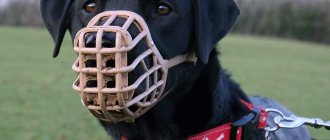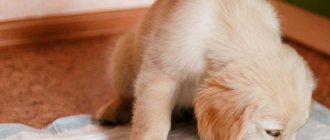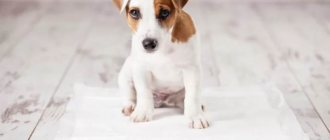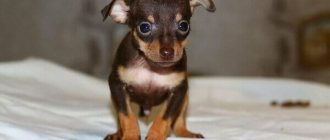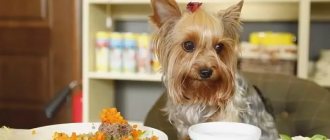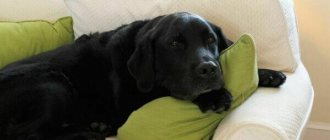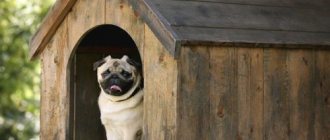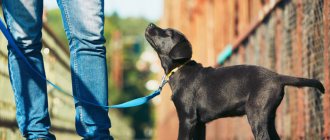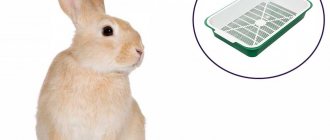The popularity of decorative dog breeds is largely due to the fact that they can be trained to use a tray. Not every owner has the opportunity to sit at home with a puppy for several months, running out into the street with him at the first natural call - for a busy person who is ready to walk the dog only once or twice a day, a diaper becomes a real salvation.
The dog’s habit of going to the toilet in a specially designated corner of the house helps to care for an elderly or injured pet, and also allows even a person with limited mobility to keep a four-legged pet. But its formation also requires basic knowledge and effort - you should read our article even if you plan to adopt a puppy from a breeder. Remember that in a new place the dog will need time to determine the place for the toilet. Natural difficulties also arise when retraining a pet that is already accustomed to relieving itself on the street.
At what age can a puppy be litter trained?
Puppies show the best results at the age of 4-5 months, but training can begin as early as 2-2.5 months. Don’t try to train a one-month old baby to a litter tray - due to its ineffectiveness, the idea will cost you your nerves. It is better to devote this time to establishing a trusting relationship with your pet and developing its social skills.
If you are adopting a puppy from a breeder - probably after 3 months of age - begin training the moment the dog arrives at home.
Popular sections:
Aquariums Sale of kittens and puppies Terrariums Products for cats Products for dogs
As for the timing of toilet training, they may vary depending on the conditions and individual characteristics of the pet. In conscious puppies learn to walk in a diaper on average in 2 weeks; some more time (about 2 months) is required to consolidate the skill.
The process can be speeded up by:
- later weaning from the mother or other adult dogs, when puppies begin to master the litter box, repeating after their older relatives;
- habituation of the animal by the breeder or previous owner;
- early weaning of the puppy if its parents did not go to the litter box or the pet was not trained in the previous home;
- absence of other animals and children in the house;
- long stay of the owner with the dog.
And remember, the older the pet, the more difficult it will be to retrain it.
How to use a litter tray, diaper or newspaper
So, the puppy's first steps in the house. How to train a puppy to go strictly to one place? There are not many training methods; it all depends on the time and capabilities available to the owner.
There are several “coverings” for toilet training a dog:
- Tray – i.e. a tray, most often plastic, but it can also be metal (wood is not suitable because it absorbs moisture and odor), which may contain filler. The filler can be either cat absorbent, grass or torn paper, newspaper or diaper. But if for a cat a filler is most often mandatory, because... A cat has a strong instinct to hide excrement by burying it deeper so that there is no smell, while dogs do not have such a need for digging - so the dog does not need litter.
- Diaper . This can be a reusable diaper that can be washed (but not in an automatic machine), or disposable diapers that can be bought at any store or pharmacy.
- Newspaper is the most versatile option. Despite the fact that a disposable diaper is more pleasant for the dog’s paws and is softer, absorbs moisture well and prevents it from leaking onto the floor, the dog will prefer to go to the newspaper. To protect the floor from liquid, you can put an oilcloth or a reusable diaper under the newspaper.
Using all these methods couldn’t be easier - the main thing is to place all these surfaces in a place convenient for the dog.
A dog is a clean animal - it will not relieve itself anywhere, and even more so will not go to the toilet in a dirty place. Immediately, as soon as the pet goes to the toilet, the diaper or newspaper needs to be cleaned.
Teaching a puppy to go to the toilet correctly
When the owner has decided on which surface the puppy will go to the toilet, it is necessary to properly teach the dog to go to the toilet.
A puppy, like a small child, is physiologically unable to endure for long. At first you will have to take the dog to the toilet up to 10-12 times a day.
First of all, it is worth temporarily removing floor coverings, shoes and soft rags from the floor. If you are training your dog to go to the toilet on a hard surface, you should not allow him to pee even once on a soft-pile carpet. It is more pleasant for a dog to go to the toilet on a soft surface and then it will be very difficult to wean him off going on carpet or wearing shoes, especially since the soft surface absorbs odors very well.
It is very important not to scold the puppy if he suddenly gets dirty in the wrong place!
A violent reaction from the owner, screaming or spanking, even light ones, can greatly frighten the dog . The only thing that can be achieved in this way is to teach the puppy to hide to go to the toilet and instead of finding puddles or piles in a visible place, the dog will go to the toilet under the bed or behind the closet.
When a puppy wants to go to the toilet, his usual playful behavior changes to anxiety. The dog whines, marks time, walks in circles. It is important not to miss the change in the puppy’s behavior and quickly take him to a diaper, tray or newspaper. After the dog goes to the toilet, you need to praise the puppy and encourage this behavior with play. This should be done every time the puppy shows signs of anxiety and wants to go to the toilet.
In addition, the puppy must be swaddled immediately after sleeping and eating; all physiological processes in the puppy’s body occur at this time.
Is it possible to litter train an adult dog?
Tray training an adult dog is difficult, but possible. This can be facilitated by the preservation of the senses, warm relationships with the owner and members of his family, as well as forced necessity (for example, the postoperative period). Be prepared to be patient - mastering the tray can take several months, and even a year to perfect the skill. If your pet has never used a diaper for its intended purpose before 12 months, it will take much longer for him to form a new habit.
Be sure to pay attention to your dog's toilet preferences. If she is used to walking, a roll of lawn grass, and subsequently a mat with artificial grass laid instead of filler, can “make friends” with the tray. If your pet rarely leaves the house, and chooses a place to suit his needs anywhere, you can train him to the litter box almost like a puppy.
Separately about diaper toilets
Today, on the shelves of pet stores and veterinary pharmacies you can see special diapers for pets. They are disposable and reusable, but they perform the same functions. Reusable diapers can be used more than 20 times, only washing is required after each dog bowel movement. It is important to understand that such diapers cannot be washed in automatic washing machines.
Often, diapers are used as litter for a litter box, but many dogs are afraid to go to such a toilet. It is possible to accustom a dog to diapers, but this should be done gradually so as not to cause stress in the animal. In addition, some dog breeders use diapers without a tray at all, placing them throughout the house. No one will argue here; everyone is the master of their own business.
When walking your dog, be sure to teach your pet to follow simple commands, and if you are new to training, we recommend that you familiarize yourself with the basic principles of dog training. You can also start training by selecting a toy or a puller simulator.
What breeds of dogs go to the litter box in the house?
Not all dog breeds are equally willing to be swaddled. Breed temperament and intellectual abilities must be taken into account. Among others, the following are considered “excellent” in the toilet issue:
- Yorkshire, toy and other small terriers;
- Pekingese and Japanese Chins;
- miniature dachshunds and poodles;
- Chinese Crested;
- Pomeranians;
- Pugs.
The more decorative the breed, the higher the pet’s chances of learning simple science.
Which is better: in a tray or outside?
Many dog breeders believe that it is better for a dog to go to the toilet outside rather than in an apartment. This option is very suitable for people who live in the private sector in their own home. Moreover, if you have a lot of free time and you only enjoy walking with your pet, it will also be useful for the dog. After all, daily walks develop in the animal the habit of going to the toilet only outside the house. But if you live in an apartment building, then constantly taking your four-legged friend outside to the toilet causes some difficulties.
In addition, veterinarians recommend that some breeds can be trained as soon as you bring your pet home:
- Yorkshire Terriers;
- Pugs;
- Pekingese;
- Spitz;
- Chinese Crested;
- Chihuahua.
The fact is that the size of these dogs differs little from the size of cats, and this makes it possible to select a tray for them without any problems. Only you have the choice of how to make going to the toilet comfortable for your pet. After all, if a dog feels good, goes to the toilet comfortably and correctly, it means that it is healthy and happy. And if the pet feels happy, then the owner will have no reason to be in a bad mood towards his pet.
How to choose a litter box for your dog?
When choosing a dog litter box, you should not rely only on your own measurements - it would be much better to “try on” the container and place your pet in it. For this reason, it is better to buy the first tray offline or on the recommendation of an experienced consultant. Do not forget that puppies grow very quickly, and therefore it is better to use a toilet for growth. There is a high chance that your four-legged friend will not like a tray that is too small - dogs prefer space.
Under no circumstances should you buy a cat litter box for your pet - cases of dogs being accustomed to them are known, but extremely rare.
The general principle of dog litter trays varies little depending on their type. A dog toilet is a tray made of plastic or galvanized metal, the bottom of which is covered with a diaper or a rubberized mat or grate. The smaller the breed or height at the withers, the lower the sides of the toilet should be. So, for Chihuahuas they often produce bellyless models.
For male dogs, models are produced with a special post, which allows you to avoid marks on walls and furniture. The post usually has a system of attachment to the grille, which allows you to rearrange it if necessary.
For owners with allergies, we can recommend trays with clamps, thanks to which the absorbent diaper is securely fastened, preventing the spread of odor throughout the house. Remember that the filler in devices of this type needs to be changed more often.
"Little dirty tricks"
In general, many people know the sad fact that small dogs can be very harmful. If we take the same toy terrier, then many owners complain about the dog’s tendency to demonstratively “spring” to the floor. This happens in cases where pets openly sit on their owners’ necks. With the help of such a simple means, they simply show their dominant position in the family. If you don't want to say goodbye to your nerves and floor coverings, you'll have to be stricter.
There is no need to arrange “punishment with whips”. At the slightest sign of disobedience, it’s quite simple to lock the dog in that very separate room with a potty. One. If he still deigns to go to the tray to do his business, praise him and give him a treat. Otherwise, show him your displeasure and leave him without something tasty.
However, in some cases the dog frankly does not like the urinal. As a rule, this happens if they try to force a small Spitz to walk into a tray, over the sides of which he is simply not able to climb due to their great height! Of course, he obviously won't be happy. In addition, animals are sometimes much cleaner than their owners, and therefore are in no hurry to get into the toilet, the filling of which has not been changed for a couple of weeks. Not only does it smell bad, but it can cause chemical burns on your paw pads!
Dog Litter Litter
Unlike cats, who instinctively bury their excrement, dogs have no need for loose litter. For them, the absorbent characteristics of the material are a priority, since a clean dog would never go to a dirty, wet litter box.
Therefore, in trays without a grid, the most popular material for covering is newspaper or other paper, as well as a diaper. If your dog moves it with his paws or likes to play with the sheets, you might want to consider installing a grill or changing the litter.
The second place is occupied by special mats with artificial grass, or rubber options with special grooves. Rare dogs go to sawdust or other traditionally “cat” litter. Some owners even use hay as bedding.
It is often possible to do without a tray - if the dog is careful and does not move the toilet, you can lay a disposable or reusable diaper on the floor. The first option is more convenient in terms of time costs and is well suited for allergy sufferers, while the second is more economical and environmentally friendly. You can read more about diapers here.
Types of toilets for dogs
Previously, when talking about home toilet for animals, we mainly meant trays filled with sand, sawdust or even paper. But demand creates supply, and the development of the industry does not stand still, so today there are many much more convenient devices for a dog toilet in an apartment.
The most popular among them:
- Pillar toilet. It is good because the animal can do the job by habitually raising its paw to the post. In this case, the contents do not splash onto nearby furniture or a wall, but flow down the column directly into the pot. As a result, the pet obeys its instincts, and the owner receives a hygienic option, in which it is enough to wash the tray, and a convenient installation location.
- Absorbent diapers. They can be placed at the bottom of the potty or simply on the floor in the room, which is very convenient with very small puppies or sick dogs that are not able to actively climb over the sides. The used diaper is disposed of along with the trash, so the dog’s owner doesn’t even have to wash the toilet area.
- Tray with filler. At its core, it is no different from a cat, except for size. A special adsorbent material is placed at the bottom, which can simply be removed with a special spatula. The undoubted advantage of this option is the complete absence of odor if it is replaced on time. It is true that it is important to choose a substance that the puppy will not try to eat, and if he tries, he will not be poisoned. Sometimes, instead of filler, a special plastic grid is placed in the tray, through which excrement flows down, but then there is no need to talk about the absence of odors.
- Tray with imitation lawn. It is designed in such a way that an imitation of green grass is placed on its upper part, under which there is a spacious tray, which receives the puppy’s waste. Such a tray looks good in an apartment, and even completely blocks out the stench, allowing you to wash the toilet only once every few days.
All other options, when a dog or puppy is asked to do business in a room using a newspaper or in an ordinary basin filled with sand, are extremely unhygienic, and the dog rarely likes it.
Choosing a location for the dog litter box
Initially, poor placement of the toilet can cause a lot of “misfires” in the puppy and lead to conflicts with the owner and family members. When choosing a location for your dog litter box, consider the following principles:
- the place should be convenient for both the puppy and the owner, since changing the location of the toilet has a negative impact on training;
- make sure that, in addition to the diaper, there are no other soft absorbent materials on the floor, such as carpets or rags;
- Try to choose a room where you can limit the puppy's movement.
For very small pets, you can build a fence, gradually increasing the living space from 1.5 sq.m as they grow. The fewer places to relieve yourself, the higher the likelihood that the dog will choose a diaper as a toilet.
What is a toilet diaper and what is it used for?
Dog diapers are common among owners. They are comparable in principle and effectiveness to baby diapers and feminine pads. Due to the waterproof bottom layer and adsorbent, water does not leak out and odor does not spread. Diapers are placed in a tray or used as a full-fledged toilet for a pet. They are also used when teaching a puppy to pee in one place.
The main advantages are:
- Ability to absorb liquid quickly. The diaper remains dry on the surface, which provides the animal with comfort.
- Resistant to damage, it is difficult to tear it with claws.
- The volume of absorbed moisture is 2 liters.
- The adsorbent contains no dangerous or harmful substances.
Its varieties
Diapers sold in pet stores are divided into three types:
- Disposable. They will need to be thrown away after use. This is an economical option. Available in different colors and sizes. Sometimes they have a sticky bottom layer that helps stick the diaper to a smooth surface.
- Reusable. Their validity period is up to 12 months. It is necessary to wash the diaper at least once every two to three days. Use any cleaning products for processing. It contains an absorbent substance that firmly holds liquid, so that the surface will always be dry. The cost of the type in question is much higher, but this is due to its cost-effectiveness in use.
- Accustoming. They have all the qualities discussed above. The diapers also have a scent that pets mistake for the smell of grass. This makes it easier to accustom the puppy to a diaper in the apartment and a toilet outside in the future. This type is also suitable for elderly and sick animals.
Certain types have built-in humidity indicators. They indicate to the owner that the diaper requires washing or replacement. There are options with antibacterial impregnation.
How to train a dog to use a litter box?
1. Limit the space you can move. The most convenient way would be to organize the puppy’s living space so that it is always convenient for you to keep an eye on him. This will help you respond in a timely manner to your baby’s attempts to sit down.
2. For the time being, remove all soft bedding from the premises accessible to the puppy. Natural cleanliness often becomes the reason that a pet chooses the surface for the toilet that best absorbs urine and retains odors. What absorbs moisture better than carpets?
3. Choose a location for the litter box based on your puppy's preferences, or place it further away from the aisle.
4. Follow the regime. Usually puppies run to pee after waking up and poop after eating. Transfer your pet to the tray in advance, gently talking to him and stroking him. Don't forcefully hold your dog in the crate, but gently return him if he tries to run away without getting the job done. Do not let the puppy run around the entire apartment until he has had a bowel movement.
5. Be sure to reward your pet with vocal praise and a favorite treat immediately after completing the process.
6. Do not yell at the puppy, do not hit or humiliate him if he wanders by. If you catch your pet committing a crime, loudly and unexpectedly say “ugh,” clap your hands, and scold the puppy. A look of shame (ears flattened, pleading look) is more than enough. If you are late and an incident occurs, remove the feces and wash the floor thoroughly so that there is no smell left. Before doing this, it is advisable to dip a piece of paper in them and put it in the tray, leaving a kind of olfactory anchor for the puppy.
How to train a two-month-old puppy to go to the toilet?
Little tricks on how to quickly train a puppy to use the litter box
- As soon as the puppy begins to spin around and look for somewhere to sit, bring him to the tray.
- After eating and sleeping, also place the baby in his tray. ...
- If the puppy goes to the litter box, praise him. ...
- If your baby makes a puddle on the floor, blot it up with a diaper.
Interesting materials:
What is dissonance in music? What is distribution in linguistics? What is discirculatory? What is the back length of the product? What is the length of the river? What is flange DN? What is benign prostatic hyperplasia? What is the quality factor of a speaker? What is the quality factor of an oscillator? What is a Kazakhstan gas and gas agreement?
How to deal with learning difficulties?
If your dog does not use the litter box, take a closer look at his behavior and surroundings. Perhaps alternative bedding is preferable to diapers for her - in this case, it is worth excluding the pet’s access to carpets, beds, upholstered furniture and secluded places, such as boxes. Or the animal prefers dark corners, where it can relieve itself away from its owner’s eyes. This behavior is usually typical of adolescents and adult dogs that have undergone incorrect and traumatic training from previous owners.
When keeping a puppy, remember that little pets are just learning to control urination and defecation, and therefore trays and diapers should be within walking distance so that a child who is playing or overeating has time to reach them. Subsequently, the number of toilet places can be gradually reduced.
Dogs already accustomed to the street may look for a substitute for grass - for example, terry blankets. Lay them on a special mat or use natural materials as bedding for the first time.
If your pet is too clean or you are away from home for a long time, provide him with several litter trays so that he can go to the toilet without getting his paws dirty. Also, protest may be caused by the tray being too small, unstable, or having inconvenient sides.
For a dog of any age that has only recently arrived in the home, mastering the living space is inextricably linked with setting boundaries. Being territorial animals, dogs instinctively mark their territory, often marking places where boundaries may be violated by strangers - near doorways and window openings. Do not forget to limit the area of movement for the first time, and also do not take into bed an animal that does not yet control its urges.
If your pet came to you as an adult, pay attention to whether it gets along with your household, whether it gets enough attention, and whether it competes with other pets. In some cases, violation of toilet rules may indicate diseases of the genitourinary tract, conflict with someone at home, or boredom. Sometimes castration of a pet that is not intended for breeding helps solve the problem. Trays with posts are offered for breeding dogs to demonstrate their dominance.
Remember that dogs prefer to go to the toilet in the same place, which retains their scent. Be sure to clean the wrong areas using household and special products to avoid relapses. Sometimes products such as “Antipis” and “Antiodor” for surface treatment help solve the problem.
If none of the methods helped you, as well as the recommendations of the breeders, think about purchasing dog diapers. They will also help you avoid unpleasant incidents at a party.
Useful tips
There are a number of useful tips and recommendations for training a dog to use a tray, which were compiled by experienced dog breeders and veterinarians:
- Immediately after eating or sleeping, lock your pet in a room with a litter box. The fact is that the dog, at the subconscious level, will want to defecate after eating and after resting.
- When locking an animal in a room with a poop container, expect a happy ending and never open the door prematurely. If the job is done according to the rules, then praise the dog; if everything is not as you expected, scold, but without being too enthusiastic.
- The door to the room with the toilet container must always be open. If your pet does not have time to reach the toilet, you need to wipe the puddle with a diaper and put it in the tray. The place where the dog defecated must be thoroughly washed to remove excess odors. Otherwise, the dog will smell this place the next time he wants to go to the toilet.
- Regularly take your dog to the diaper tray and point out in a firm tone that this is his toilet.
- Never raise your voice too loudly or for too long at a dog, especially don’t hit him. He is able to remember all the grievances; In addition, excessive stress can lead to regular urination in the wrong place.
Important! When cleaning the house, it is prohibited to use bleach and ammonia. The fact is that urine also contains ammonia, which can attract the animal to defecate in the wrong place.
What not to do?
Be consistent and clear in the process of training your puppy, try to maintain his sense of trust in a person and safety in your society. Also remember that to create a conditioned reflex, it is necessary to maintain the shortest possible time intervals between the action and the reward. Absolutely not worth it:
- praise or blame your pet upon discovering a pile or puddle, if they were not made in your presence;
- spanking or otherwise physically punishing the dog, especially before 4 months of age when puppies are especially susceptible;
- use only negative motivation and do not reward your pet after correct actions;
- forget about negative reinforcement (even if you are soft-hearted, to raise a dog you still need to establish what is acceptable and what is not);
- punish the pet by depriving it of food or entertainment;
- lock it up with the stool or poke your nose into it;
- use ammonia detergents (they may have the opposite effect).
It is very important to reinforce in the dog’s mind the sequence “if you missed the tray, you met with condemnation.” If you punish the puppy not for the prank itself, but for the excrement that is subsequently discovered, he will most likely begin to hide traces of the crime - for example, lick it off in fear of punishment or shit in secluded corners.
We teach the dog to ask to go to the toilet outside
Requiring your puppy to go to the toilet only outside is completely pointless . Up to 4 months, the dog physiologically cannot tolerate walking, and up to 6 months, incidents can happen at home. In addition, until all vaccinations have been completed, the puppy must be in quarantine and walking it means endangering its health.
When the dog reaches the age when the main vaccination has been carried out and the dog can physically tolerate walking, street training should begin:
- Set aside a few days to develop the habit of asking your dog to go to the toilet. It only takes a few days to practice the skill – it doesn’t have to be a vacation, you can choose a weekend and devote it to training your puppy.
- Stock up on treats . Any correct action of the dog should be rewarded - with food or play, but rewarding is mandatory.
- So, as soon as the puppy begins to show anxiety, you immediately need to take him outside. It is advisable that the walking area be far from busy roads and public places - nothing should distract the dog from the purpose of walking.
- If the puppy is walking on a leash, the leash should be slack, the dog should not be distracted or tugged on the leash . If the puppy is walking without a leash, he must be released so that nothing distracts him from the toilet.
- As soon as the dog does its business, at the same moment, this is important, it needs to be praised and encouraged with a treat or game.
- And under no circumstances should you end your walk immediately after using the toilet. If you go home immediately after the dog has done its business, the dog remembers the toilet-house chain, which means that in order to take a walk and frolic, you need to be patient. And until the last moment she will jump and run around on the street, not doing her main business - for her, the toilet will be associated with the end of the walk.
Accustoming a puppy to walking is quite simple and requires only a few days and systematic implementation.
It will be more difficult with an older dog . In general, training and habituating an adult dog is no different from training a puppy, with the exception that an adult dog can and should be scolded for incorrect behavior. But as soon as the dog begins to whine and show restlessness, just like a puppy, it must be immediately taken outside, praised after relieving itself, and not interrupted the walk immediately after using the toilet.
Training an adult dog may take a little longer than a puppy, but this is all very individual and depends only on the dog’s abilities and the patience of the owner.
How to properly walk your pet outside
According to the law, dogs must be on a leash and muzzle in public places. In urban areas it is quite difficult to find places for walking dogs, but at a dog walking area you can let your dog off the leash and, of course, remove the muzzle.
There are several rules for walking a dog:
- As soon as the dog has gone to the toilet, you cannot immediately take it home.
- You only need to walk your dog in an urban environment on a leash - this will protect not only the nerves of passers-by, but also the dog from aggressive dogs and negativity from people.
- At the dog walking area, you can let your pet off the leash, but if the animal shows aggression towards other dogs, the muzzle cannot be removed.
At what age should you train a puppy?
Until all age-required vaccinations have been completed, you cannot walk with your pet for medical reasons.
- From about 3 months , when the vaccination quarantine ends, you need to accustom the dog to walking outside.
- From 4 months, the dog can tolerate walking 3-4 times a day. It is important to remember that up to six months a puppy cannot always endure the next walk and you should not scold him if things have already been done and time has passed.
- From about 6 months of age, the animal can tolerate walking 3 times a day.
Methods of influence
There are only two methods of influence - positive and negative reinforcement.
- Negative reinforcement can only be used with an adult dog. Under no circumstances should you scold, much less spank, a puppy, so as not to lose contact with the animal.
- Positive reinforcement is a treat, a game, praise from the owner, a clicker, etc. something that will cause an extremely pleasant reaction and memories in the dog.
Magic bell
To develop the skill of asking to go to the toilet, you can use a bell. Its function is that when the dog wants to go to the toilet, it rings the bell.
- First you need to accustom the dog to the sound of the bell so that it is not afraid of it and associates it with pleasant associations.
- It is not difficult to teach her to ring a bell with her nose or paw - when she performs the desired action, immediately reinforce this action with a treat.
- When the dog is no longer afraid of the sound, the bell should be hung on the door handle. And in the case when the dog restlessly asks to go to the toilet, you need to bring it to the bell and show it that you need to touch the bell with your paw so that the sound is heard, and then, immediately after performing the correct action, go for a walk. The dog will quickly understand the bell-street connection and will subsequently communicate the desire to go outside using the bell.
- Another way to teach a specific action is a command that encourages action - for example, “toilet”, “pee” or any other word that will be associated with physiological processes.
It is not difficult to develop a command - as soon as the dog runs out into the street to relieve itself, immediately give the command, and, having completed its business, be sure to praise it by giving it a treat and repeating the command.
What could go wrong
It is not very difficult to train a dog to walk or go to the toilet in a diaper; the main thing is to have patience. If the dog owner cannot cope with the dog, you should contact a training professional - perhaps the dog requires the intervention of a specialist and this is not the owner’s fault.
All dogs are trainable, but different dogs require different amounts of time to learn a skill and remember a command.
Teaching a dog to properly walk and use the toilet is not a very difficult task, especially for the owner of a puppy. But any training requires the attention and patience of the owner - only in this case will success be quick and lasting.
5 / 5 ( 2 voices)
What problems can you encounter during training?
When accustoming your pet to a diaper, you need to maintain a trusting relationship, be patient and not be nervous. If the listed methods have been applied and there is no result, it is worth changing the material. For example, use paper or fabric and treat it with a special spray. It is important to ensure that the diaper or diaper change is kept clean at all times. Animals usually do not want to relieve themselves in a dirty place.
If you plan to walk your pet for the toilet, you need to go outside often. It is better to do this after waking up and eating. Then the dog will definitely get used to going to the toilet in the right place.
Sometimes it happens that the owner follows the rules discussed above, but the baby or adult pet still does not get used to the toilet. For such a case, there is also a way.
In pet stores you can find special indoor enclosures. It is worth purchasing them or limiting the area using improvised means. For this purpose, 1.5-2 square meters is enough. m. This will not harm the dog, but it will be easier for her to get used to the diaper or tray. The pet will not start peeing where she eats and sleeps. Then he will have to go to the toilet in the right place. In the enclosure it is necessary to provide a bowl for drinking and food, toys, and a bed.
After your dog relieves himself, it is important to give him a treat and praise. The area should be gradually increased. It is necessary to ensure that the pet has no other options for the toilet. The tray must be in one place. Then the pet will understand what is required of him and will behave correctly.
Owners can be helped by purchasing drops and sprays to attract the dog to the diaper. Species for repelling animals are sold. The most common remedies are “Beaphar”, “Mr. Fresh", "Api-San".
